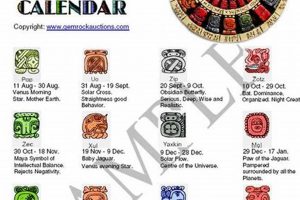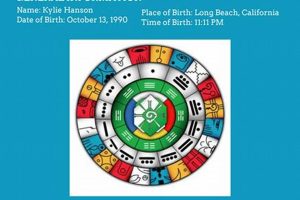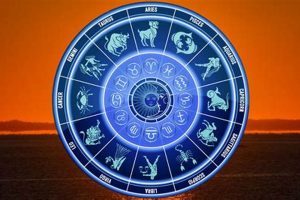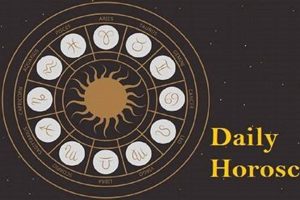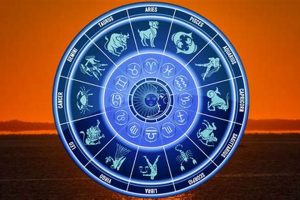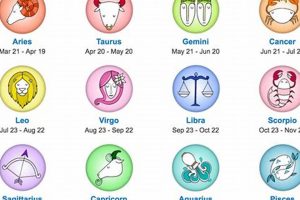A system rooted in ancient Mesoamerican beliefs, this form of divination utilizes a complex calendar system to understand personality traits, predict life events, and offer spiritual guidance. It incorporates elements such as the Tzolkin (sacred calendar) and the Haab (civil calendar), weaving together an intricate tapestry of celestial influences. An individual’s birth date corresponds to specific energies and deities, illuminating their strengths, weaknesses, and karmic path.
Offering a framework for self-discovery, this practice provides insights into individual purpose and potential. By understanding these cyclical patterns, individuals can navigate life’s challenges and opportunities with greater awareness. This ancient system remains relevant for many as a tool for personal growth and spiritual exploration, offering a connection to a rich cultural heritage.
Further exploration will delve into the specific components of this divinatory system, including the significance of the various calendars, the roles of the Mayan deities, and how these elements combine to create a personalized reading. The following sections will provide a detailed examination of these intricate aspects, offering a deeper understanding of this ancient practice.
Tips for Understanding Your Mayan Astrological Profile
Gaining deeper insight into one’s Mayan astrological profile can be a journey of self-discovery. These tips offer guidance for navigating this ancient system and applying its wisdom to daily life.
Tip 1: Determine Your Birth Date: Accurate interpretation requires precise birth date information. Consult resources specializing in Mayan calendar conversions to determine the corresponding glyphs and energies.
Tip 2: Research Your Day Sign and Year Bearer: Each day and year aligns with specific energies influencing personality and life path. Explore the unique characteristics associated with these signs.
Tip 3: Understand the Tzolkin and Haab Calendars: These interwoven calendars form the foundation of this astrological system. Learning their interplay is crucial for comprehending their combined influence.
Tip 4: Explore the Mayan Pantheon: Familiarize yourself with the Mayan deities. Each is associated with particular energies and domains, offering deeper understanding of one’s profile.
Tip 5: Consult Reputable Sources: Seek information from scholars and practitioners specializing in Mayan cosmology. This ensures accurate interpretation and avoids misinformation.
Tip 6: Apply Insights to Personal Growth: Use the insights gained to enhance self-awareness and navigate life’s challenges. This ancient wisdom can be a powerful tool for personal development.
Tip 7: Respect Cultural Sensitivity: Approach this ancient practice with respect and avoid generalizations. Recognize its significance within Mayan culture.
By understanding these fundamental principles, individuals can unlock the potential for greater self-awareness and navigate life with a deeper understanding of their unique energetic blueprint.
These tips provide a starting point for a journey of exploration. Further research and consultation with experienced practitioners can deepen understanding and facilitate a more profound connection with this ancient system.
1. Tzolkin Calendar
The Tzolkin calendar serves as a cornerstone of the Mayan astrological system. A 260-day sacred calendar, it interweaves 13 numbered days with 20 named day signs, creating a unique energetic cycle. Understanding its structure is essential for interpreting a Mayan astrological chart.
- Day Sign Energies:
Each of the 20 day signs possesses unique characteristics and symbolic meanings. These energies influence personality traits, strengths, and challenges. For example, Imix represents primal beginnings and nurturing energy, while Ik signifies wind and breath, symbolizing communication and intellect. These day sign energies contribute significantly to the interpretation of one’s Mayan astrological profile.
- Numbered Days (Trecenas):
The 13 numbered days, known as trecenas, add another layer of complexity to the Tzolkin. Each number holds a specific energetic vibration, influencing the intensity and expression of the corresponding day sign. For instance, 1 Imix represents the pure, initial manifestation of Imix’s energy, while 7 Imix might represent a more developed or challenged expression of that energy. The interplay between the number and the day sign adds depth to the astrological interpretation.
- Combined Influence with the Haab Calendar:
The Tzolkin operates in conjunction with the 365-day Haab calendar. The combined cycles create a Calendar Round, a 52-year period marking significant cycles in Mayan cosmology. This interplay further refines the interpretation of a Mayan astrological chart, providing a broader context for understanding life cycles and recurring themes.
- Divination and Guidance:
The Tzolkin serves as a tool for divination and guidance. By understanding the energies associated with one’s birth date within the Tzolkin, individuals can gain insight into their strengths, weaknesses, and life purpose. This calendar provides a framework for understanding recurring patterns and navigating life’s challenges with greater awareness.
The Tzolkin calendar, therefore, offers a profound framework for understanding the intricacies of the Mayan astrological system. By exploring the interplay of day signs, numbered days, and the combined influence of the Haab calendar, individuals can gain a deeper understanding of their unique energetic blueprint and its implications for their life path.
2. Haab Calendar
The Haab calendar, a 365-day solar calendar, plays a crucial role in the interpretation of a Mayan astrological chart. While the Tzolkin calendar focuses on sacred cycles and energies, the Haab grounds these energies in the earthly realm, reflecting the cycles of nature and the solar year. This connection to the physical world provides a practical framework for understanding how the Tzolkin energies manifest in daily life.
- Winal (Months):
The Haab year comprises 18 winals, or months, each consisting of 20 days. These months reflect agricultural cycles and seasonal changes. For instance, the winal of Mol corresponds to the gathering of water, while the winal of Yaxkin relates to the sun’s renewal. The winal of one’s birth influences how the energies of the Tzolkin manifest within the context of the natural world.
- Wayeb (Five Unlucky Days):
Following the 18 winals are five days known as Wayeb. Considered a time of transition and reflection, Wayeb represents a period outside the regular calendar cycle. Births during Wayeb were often associated with specific challenges or unique spiritual insights. This period adds a layer of nuance to the interpretation of a Mayan astrological chart, highlighting potential vulnerabilities or opportunities for transformation.
- Calendar Round and Long Count:
The Haab calendar interacts with both the Tzolkin and the Long Count calendar. The meshing of the Haab and Tzolkin creates the 52-year Calendar Round, influencing cyclical patterns in one’s life. The Long Count, a linear calendar tracking vast periods, provides a larger historical context for understanding one’s place within Mayan cosmology. These interactions highlight the intricate interconnectedness of Mayan timekeeping systems.
- Agricultural and Ritual Significance:
The Haab calendar served as a practical guide for agricultural practices, aligning daily life with seasonal rhythms. Specific rituals and ceremonies were also associated with particular winals, strengthening the connection between the calendar and daily practices. This practical application grounded spiritual beliefs in the tangible world, demonstrating the integral role of the Haab calendar in Mayan society.
The Haab calendar provides the earthly context within which the energies of the Tzolkin operate. By understanding the interplay between these two calendars, along with the Long Count, a more complete and nuanced understanding of a Mayan astrological chart emerges, offering a rich tapestry of interwoven influences shaping individual destiny.
3. Day Signs (Glyphs)
Within a Mayan astrological chart, day signs, represented by glyphs, function as fundamental building blocks. These glyphs, each imbued with unique energetic qualities, provide a framework for understanding personality traits, predicting life events, and offering guidance on one’s life path. Their significance lies in their ability to connect individuals to the complex interplay of Mayan cosmology and the energies that shape individual destinies.
- Symbolic Meanings:
Each glyph possesses a symbolic meaning derived from Mayan mythology and natural phenomena. Imix, for example, symbolizes primordial waters and creation, associating individuals born under this sign with nurturing and foundational energies. Cauac, representing storm and rain, connects individuals with transformative power and emotional depth. These symbolic meanings offer insight into individual characteristics and potential life paths.
- Personality Traits:
Day signs offer insights into personality traits and predispositions. Individuals born under the sign of Ahau, associated with the sun, often exhibit leadership qualities and a strong sense of self. Men, on the other hand, associated with the eagle and knowledge, often possess intellectual curiosity and a keen eye for detail. Understanding these inherent tendencies allows individuals to leverage their strengths and navigate potential challenges.
- Interaction with Tzolkin and Haab:
Day signs are integral to both the Tzolkin and Haab calendars. In the Tzolkin, they combine with the 13 numbered days to create unique energetic combinations, while in the Haab, they interact with the winals (months) to provide context for how these energies manifest within the solar year. This interplay contributes to the complexity and depth of a Mayan astrological chart.
- Influence of Mayan Deities:
Each day sign is associated with a specific Mayan deity. This connection further refines the interpretation of the glyph’s influence. For instance, the day sign Chicchan is associated with the serpent deity Kukulkan, imbuing individuals born under this sign with qualities of wisdom, transformation, and spiritual power. These divine associations provide additional layers of meaning and insight.
Day signs, as represented by their glyphs, constitute an essential component of a Mayan astrological chart. Their symbolic meanings, influence on personality traits, interaction with the calendar systems, and connection to Mayan deities contribute to a multifaceted understanding of individual destinies. By deciphering the language of these glyphs, a deeper connection to Mayan cosmology and personal potential can be achieved.
4. Year Bearers (Glyphs)
Year bearers, also represented by glyphs, hold a significant position within a Mayan astrological chart, influencing the overarching energy of a person’s birth year. Unlike day signs, which relate to the specific day of birth, year bearers provide a broader context, shaping the general themes and influences that may unfold throughout a lifetime. These glyphs are essential for understanding the cyclical nature of Mayan time and its impact on individual destinies. The year bearer interacts with the day sign, creating a complex interplay of energies that contributes to a nuanced understanding of one’s astrological profile.
For example, if a person is born in a year governed by the year bearer Kan, associated with the maize god and representing growth and abundance, this influence may imbue the individual with a natural inclination towards nurturing, creativity, and a strong connection to the earth. However, the specific expression of these qualities will be further refined by the individual’s day sign. A Kan year bearer combined with a day sign like Oc, associated with the dog and representing loyalty and companionship, might suggest a person who expresses their nurturing qualities through strong bonds with family and friends. Alternatively, a Kan year bearer combined with a day sign like Etznab, associated with obsidian and representing sharp intellect and transformation, might suggest a person who channels their creative energy into innovative pursuits and transformative experiences. Therefore, understanding the combined influence of both the year bearer and day sign is crucial for a complete interpretation.
The significance of year bearers extends beyond individual interpretation. They also play a crucial role in understanding historical cycles and collective influences. By studying the year bearer associated with specific historical periods, insights can be gained into the prevailing energies and challenges of those times. This broader perspective helps connect individual experiences to larger societal and historical contexts. Comprehending the role of year bearers within a Mayan astrological chart deepens one’s understanding of the intricate web of influences shaping both individual lives and the unfolding of time itself.
5. Mayan Deities
Mayan deities play an integral role in the interpretation of a Mayan astrological chart, acting as personified energies that imbue each day sign and year bearer with specific characteristics and influences. These deities are not simply symbolic figures but are considered active forces shaping individual destinies and the world at large. Their presence within the astrological system provides a framework for understanding the complex interplay of cosmic energies and their impact on human lives. The association of deities with specific glyphs adds depth and nuance to the interpretation of one’s astrological profile, offering insight into strengths, weaknesses, and potential life paths. For instance, the deity Itzamn, associated with creation and wisdom, imbues the day sign Imix with qualities of nurturing, foundational strength, and a connection to the primordial forces of the universe. Alternatively, the deity Ix Chel, associated with the moon, weaving, and medicine, connects the day sign Ix with themes of healing, creativity, and cyclical change. These divine associations offer a deeper understanding of the energies at play within an individual’s chart.
Understanding the specific attributes and domains of each deity is crucial for a comprehensive interpretation of a Mayan astrological chart. Each deity governs specific aspects of life, such as agriculture, warfare, art, or commerce, and these domains influence the expression of the associated day sign or year bearer. For example, the deity Chaac, associated with rain and agriculture, imbues the day sign Oc with a connection to nourishment, community, and the cyclical rhythms of nature. A person born under this sign might be drawn to careers in agriculture, environmentalism, or community service. Furthermore, the narratives and myths surrounding each deity provide valuable context for understanding the complexities of their influence. The story of the Hero Twins, for example, illuminates the struggle between light and darkness, a recurring theme in Mayan cosmology, and adds a layer of symbolic depth to the interpretation of the associated day signs, Hunahpu and Xbalanque.
The presence of Mayan deities within the astrological system offers not only a framework for understanding personality traits and life paths but also a pathway for connecting with a rich spiritual tradition. By studying the attributes and mythology of the deities associated with their astrological signs, individuals can gain insights into their own spiritual potential and cultivate a deeper connection to the Mayan worldview. This understanding allows for a more nuanced and personalized interpretation of the astrological chart, moving beyond simple character assessments and providing a framework for personal growth and spiritual exploration. It is important to approach these deities with respect and acknowledge their cultural significance within the Mayan tradition, avoiding simplistic interpretations or cultural appropriation.
6. Energetic Influences
Energetic influences form the core principle underlying a Mayan astrological chart. This system posits that the cosmos exerts specific energies influencing individuals based on their birth date. These energies, interpreted through the interplay of the Tzolkin and Haab calendars, day signs, year bearers, and associated deities, shape personality traits, life paths, and potential experiences. Understanding these influences provides a framework for navigating life’s challenges and realizing one’s potential. For example, an individual born under the day sign Imix, associated with the deity Itzamn, might experience a strong connection to primal energies, manifesting as a nurturing disposition or a deep connection to nature. This influence, however, is further shaped by the individual’s year bearer and the specific combination of the Tzolkin and Haab calendars on their birth date.
The concept of energetic influences extends beyond individual characteristics. It also encompasses the interplay of energies between individuals and their environment. Certain day signs and year bearers are considered more compatible than others, suggesting a potential for harmonious or challenging relationships. Similarly, specific periods within the Mayan calendar are associated with particular energies conducive to certain activities, such as planting crops, undertaking journeys, or engaging in spiritual practices. Recognizing these broader energetic influences allows for a deeper understanding of the interconnectedness of life and the cyclical nature of time. Practical application of this understanding can enhance decision-making and facilitate a more harmonious relationship with the natural world.
In summary, energetic influences serve as the foundation of the Mayan astrological system. They provide a framework for understanding individual characteristics, interpersonal dynamics, and the cyclical nature of time. While interpretation requires careful consideration of the complex interplay of various calendar components and associated deities, understanding these influences offers valuable insights into one’s potential and the forces shaping individual destinies. Challenges arise in applying these ancient principles to contemporary life; however, the core concepts remain relevant for those seeking a deeper understanding of themselves and the world around them.
7. Personal Interpretations
Personal interpretations bridge the gap between the complex calculations of a Mayan astrological chart and individual lived experience. A chart, while providing a framework of energies and influences, remains a blueprint requiring individual interpretation to unlock its full potential. This process involves considering the interplay of day signs, year bearers, and associated deities, not as fixed dictates, but as dynamic forces interacting with individual free will and life circumstances. For example, two individuals born under the same day sign might express its associated traits differently due to varying life experiences, cultural contexts, and personal choices. One might embrace the nurturing qualities of Imix by pursuing a career in childcare, while another might express this energy through artistic creation or community activism. Personal interpretations, therefore, move beyond generalized descriptions, integrating astrological insights with the nuances of individual lives.
The importance of personal interpretation is further amplified by the cyclical nature of Mayan time. Recurring cycles, as indicated by the Calendar Round and Long Count, suggest potential patterns and recurring themes in one’s life. However, how these cycles manifest depends on individual choices and responses. A challenging period indicated by a particular combination of energies might lead to growth and transformation for one individual, while another might find themselves repeating past patterns. Personal interpretation allows for a proactive approach to these cycles, empowering individuals to navigate challenges with greater awareness and leverage opportunities for personal development. This understanding transforms the astrological chart from a predictive tool into a roadmap for self-discovery and conscious evolution.
While personal interpretation allows for individualization of astrological insights, it also presents potential challenges. Subjectivity can lead to misinterpretations or projections of personal biases onto the chart’s framework. Balancing individual experience with a respectful understanding of Mayan cosmology is crucial. Consulting with experienced practitioners or engaging in rigorous self-reflection can mitigate these challenges and ensure a more balanced and insightful interpretation. Ultimately, personal interpretations provide a crucial link between the ancient wisdom embedded within a Mayan astrological chart and its relevance to contemporary lives, fostering self-awareness and empowering individuals to navigate their unique life paths with greater understanding and purpose. This process requires ongoing exploration and a willingness to engage with the complexities of both the self and the cosmos.
Frequently Asked Questions
This section addresses common inquiries regarding this ancient Mesoamerican system, aiming to clarify its core principles and applications.
Question 1: How does this system differ from Western astrology?
Unlike Western astrology, which focuses on the positions of planets and stars, this Mesoamerican system utilizes a complex calendar system based on the cycles of the Tzolkin and Haab. Emphasis is placed on the energies associated with specific dates rather than planetary transits.
Question 2: What is the significance of the Calendar Round?
The Calendar Round, a 52-year cycle, represents the intersection of the 260-day Tzolkin and the 365-day Haab calendars. This cycle marks significant periods within Mayan cosmology and influences recurring themes in individual lives.
Question 3: How are day signs and year bearers determined?
Day signs and year bearers are determined based on one’s birth date using specialized conversion tools. These glyphs represent specific energies and associated deities influencing personality and life path.
Question 4: Can one change their destiny indicated by their birth chart?
This system emphasizes free will within a framework of energetic influences. While the chart offers insights into potential strengths and challenges, individuals possess the agency to shape their own destinies.
Question 5: How are deities incorporated into this system?
Deities are associated with specific day signs and year bearers, imbuing these glyphs with nuanced characteristics and influences. These divine associations provide a deeper understanding of the energies at play.
Question 6: What are the benefits of understanding this system?
This practice offers a framework for self-discovery and personal growth. It provides insights into individual strengths, weaknesses, and life purpose, enabling informed decision-making aligned with one’s energetic blueprint.
Understanding the nuances of this system requires further research and exploration. These FAQs provide a starting point for navigating its complexities and applying its wisdom to contemporary life.
Further exploration of specific deities and their influence on individual charts follows.
Conclusion
This exploration has delved into the intricacies of the Mayan astrological system, highlighting its key components: the Tzolkin and Haab calendars, day signs, year bearers, and the influence of Mayan deities. These elements combine to create a complex framework for understanding individual energies, personality traits, and potential life paths. The system offers a unique perspective on the cyclical nature of time and its impact on human experience, emphasizing the interplay of individual free will within a broader cosmic context. Furthermore, the system’s connection to a rich cultural heritage provides a bridge to the spiritual beliefs and practices of the ancient Maya.
This ancient system, while complex, offers valuable insights for self-discovery and personal growth. Further research and exploration can deepen understanding and facilitate a more nuanced appreciation of this rich tradition. By engaging with the wisdom embedded within this system, individuals can gain a deeper understanding of themselves, their place within the cosmos, and the cyclical patterns shaping their lives. This journey of exploration encourages a more conscious and purposeful approach to life, empowering individuals to navigate challenges with greater awareness and embrace opportunities for transformation.


